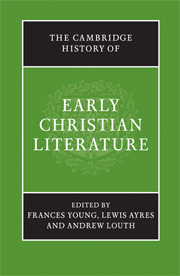Book contents
- Frontmatter
- PART ONE The Beginnings: The New Testament to Irenaeus
- PART TWO THE THIRD CENTURY
- A LITERARY GUIDE
- 11 The Alexandrians
- 12 The beginnings of Latin Christian literature
- 13 Hippolytus, Ps.-Hippolytus and the early canons
- 14 Cyprian and Novatian
- 15 The earliest Syriac literature
- 16 Concluding review: the literary culture of the third century
- B CONTEXT AND INTERPRETATION
- PART THREE FOUNDATION OF A NEW CULTURE: FROM DIOCLETIAN TO CYRIL
- Bibliographies
- Index
- Map: The Roman Empire in the late fourth century AD"
- References
16 - Concluding review: the literary culture of the third century
from A - LITERARY GUIDE
Published online by Cambridge University Press: 28 March 2008
- Frontmatter
- PART ONE The Beginnings: The New Testament to Irenaeus
- PART TWO THE THIRD CENTURY
- A LITERARY GUIDE
- 11 The Alexandrians
- 12 The beginnings of Latin Christian literature
- 13 Hippolytus, Ps.-Hippolytus and the early canons
- 14 Cyprian and Novatian
- 15 The earliest Syriac literature
- 16 Concluding review: the literary culture of the third century
- B CONTEXT AND INTERPRETATION
- PART THREE FOUNDATION OF A NEW CULTURE: FROM DIOCLETIAN TO CYRIL
- Bibliographies
- Index
- Map: The Roman Empire in the late fourth century AD"
- References
Summary
The reader of this literary guide to the third century will have been struck by the continuities and discontinuities with the material discussed in the earlier section. The continuities are enough to alert one to the artificiality of any chronological division, and it is the case that those divisions are far from absolute: the apocryphal New Testament material, for example, is by no means confined to the earliest period though we have treated it in Part I. Yet with the Alexandrians a new note is struck, and the birth of a Christian literature in Latin and Syriac marks a shift of which account must be taken. Christian texts are altogether becoming more embedded in the cultural and linguistic worlds around them, and their genres reflect that reality.
The epistolary form remains important, though those extant demonstrate subsequent interest in preserving those epistles which, having emanated from significant figures or councils, could be used to settle questions of belief or church order. Thus, apart from the collected correspondence of Cyprian, most letters from the period have survived because appeal was made to them in later controversial situations: for example, the correspondence of the two Dionysii, bishop of Rome and bishop of Alexandria, preserved by Athanasius. Others were preserved by Eusebius because they testified to the issues he was reporting. It is clear, however, that correspondence remained a significant way of keeping the scattered Christian communities in touch, and of communicating decisions which were taken to have wider import. There is both continuity and development here, paving the way for the ‘official’ communications of councils in the coming centuries, and in the case of Cyprian, for the collected correspondence of persons with standing which will become a feature of the fourth century.
- Type
- Chapter
- Information
- The Cambridge History of Early Christian Literature , pp. 172 - 178Publisher: Cambridge University PressPrint publication year: 2004

